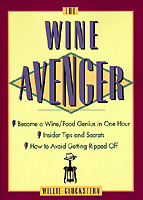 | |||||||||||||||||||
| |||||||||||||||||||
|
|
|
|||||||||||||||||

|
The Wine Avenger Willie Gluckstern
Excerpt from The Wine Avenger OAK: The MSG of Wine
Many kinds of containers are used to ferment grape juice into wine. The following are the three most popular: Stainless steel, a neutral environment. It imparts nothing to the fermenting wine-zero aroma, flavor, or mouthfeel. Used oak (barrels that have held wine in a previous year). It imparts weight and a rich, viscous mouthfeel without adding sweetness or flavoring. New oak. It adds a lot: enriched body, tannin, and certain unmistakable aromas and tastes. These include vanilla, caramel, buttered toast, and all too often, burnt popcorn kernels. Above all, new oak adds its own nonvinous, rough-hewn sweetness.
The staves of oak barrels allow mild, beneficial oxidation of wines as they age. Oak enriches a wine's body and adds viscosity. Oak's natural tannins act as a preservative for wine (important for aging big reds and a few whites). It creates a vanilla-like sweetness.
Oak is generally used in the form of barrels. Wines fermented in oak barrels are far more powerfully influenced by its character than wines merely aged in them. Oak should be applied only to a wine that already boasts substantial weight and flavor of its own, and that means rich reds, primarily. While the expert use of oak barrels in the maturation of great red wines is essential, misuse merely contributes strong barrel flavors that obliterate any varietal aromas in a wine. Very few white wine varieties reap any benefit from contact with new oak. New oak acts on white wine like MSG, sweetening up but dumbing down whatever vibrant varietal signature exists. For Chardonnay, the grape on which new oak cooperage is most often lavished, varietal character is a nonissue. As a variety, Chardonnay has so little flavor of its own that it is often entirely dependent on a winemaker's "recipe." Most Chardonnays are created in the winery with oak, not in the vineyard with pruning shears. For Riesling, Chenin Blanc, and Sauvignon Blanc, the food world's three most important white wine grape varieties, new oak is the Antichrist. The joy of these varieties as food mates is their freshness, delicacy, and succulence, all qualities that wilt in the presence of new wood.
For many years, the American public, who are by no definition daily wine drinkers, have been seduced by wines oaked in the most heavy-handed method imaginable. Virtually all under-$10 white wines produced in the United States are sugared with oak chips, powders, and essences. Oak-obsessed California winemakers simply will not let the poor palate-dead American consumer come up for air. (To be fair, neither will the Australians, South Africans, or Chileans.) It's nearly impossible to find a nonoaked domestic white wine of any kind, save a handful of East Coast whites and a very few West Coast examples (Randall Grahm's Malvasian bonbons). This begs the question: Why is virtually all white wine made in America bludgeoned with oak? American wine drinkers, as well as those of countless other nations, are weaned on cold sweet drinks fruit juice, soda pop, etc. Since all alcohol is puritanically forbidden here until at least voting age, we have never been a wine-drinking nation. Our first tentative contact with the grape is logically made most painless with a beverage of comparable sweetness to fruit juice and soda pop. Once we are initiated into a world of oaked wines, our reprogramming requires a complete reinterpretation of individual taste. There are actually grape varieties that provide us with the sort of sweetness we love without relying on enhancement by nonliving substances. Unfortunately (or fortunately), these wondrous varieties don't flourish well in most parts of the world. To satisfy the great American sweet tooth, the wine industry has marked each decade with a new "pop wine": Cold Duck in the sixties, Lambrusco in the seventies, white Zinfandel in the eighties, and finally in the nineties, the great seducer Chardonnay. Since Americans historically have little or no contact with clean, well-made, nonoaked wines, they neither understand nor enjoy them. They do enjoy the concept of wine as long as it doesn't taste like wine. Oaked wines are far easier for non-wine-drinkers to deal with. They are mild, low-acid, sweet beverages that are popular for many of the some reasons as fastfood hamburgers: The taste is reliable, always the same not great but no surprises. The wine establishment, because of a combination of taking the path of least resistance and its own nonenlightened wine experience, has become an unwitting accomplice to this oak-driven madness. When consumers, retailers, and restaurateurs cease associating the aroma of oak with quality, perhaps winemakers will stop abusing it. In my twenty-five years' experience teaching consumer and wait staff wine classes, I've found that when someone who's genuinely interested in wine tastes a range of examples uninfluenced by new-oak treatment, set out side by side with oaked wines, they become instant converts to "the real thing." From The Wine Avenger, by Willie Gluckstern, Ben Crumlich(Illustrator). ©June 1998, Willie Gluckstern, Ben Crumlich(Illustrator) used by permission. Find Items On Similar Subjects | |||||||||||||||||
All materials contained in http://www.WineCountryTravel.com are protected by copyright and trademark laws and may not be used for any purpose whatsoever other than private, non-commercial viewing purposes. Derivative works and other unauthorized copying or use of stills, video footage, text or graphics is expressly prohibited. |
